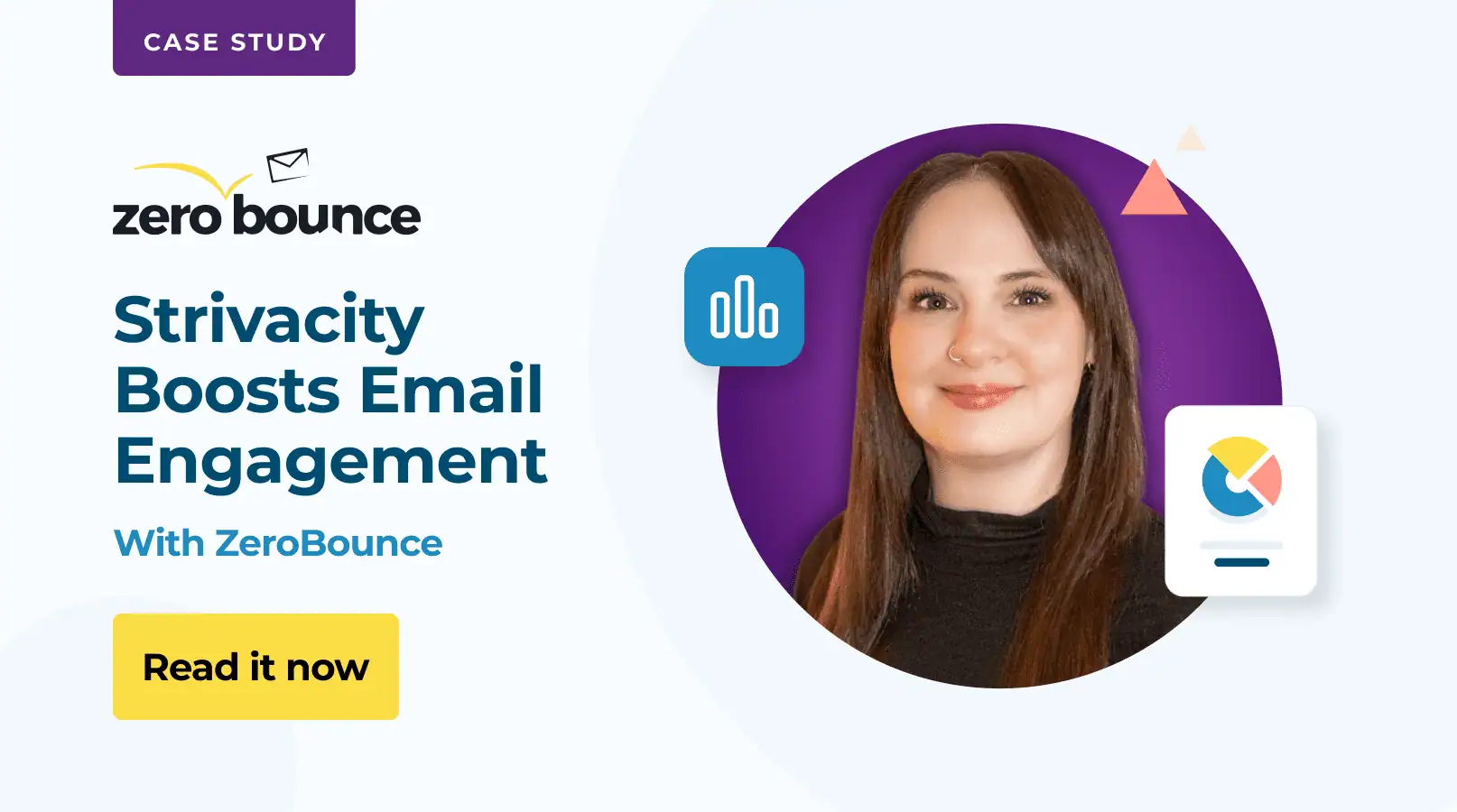ZeroBounce Case Studies
ZeroBounce is proud to provide marketers and business owners with our unbiased email verification case studies. We work with some of the biggest brands worldwide and play a pivotal role in driving the results of their email marketing campaigns.
They came up to us with messy databases that took just minutes to clean. We purged duplicate email addresses and added missing data - at no charge. Our tools help brands validate their emails, saving money and helping them take advantage of valuable leads.
Read their case studies to see how our email validation tools restored their sender reputation and helped increase email revenue.
Get 100 free monthly email verifications when you sign up with a business/premium domain.




Partner Case Studies

CASE STUDY
Strivacity Boosts Email Engagement and List Health with ZeroBounce
When Strivacity needed to clean a 30,000+ contact database ahead of a major campaign, the team turned to ZeroBounce. In just an hour, they validated their list and got their campaigns off the ground – with immediate improvements in email deliverabilityⓘA sender’s ability to reach the recipient’s inbox with their outgoing emails. It may also describe the ratio of emails delivered to the inbox vs. those sent to spam or blocked by the receiving server. and engagement.
Read More

CASE STUDY
How The Links Guy Improves Email Bounce Rates with ZeroBounce
When The Links Guy and his team hit a 10% bounce rate, they knew something had to change. With their sender reputation at risk, they couldn’t afford to ignore their email list issues any longer. That’s when they reached out to ZeroBounce for help.
Read More

CASE STUDY
How Belkins Masters B2B Lead Generation with Better Data
A high bounce rate can damage your entire email marketing program – and Belkins learned that first-hand. See how ZeroBounce helped the B2B lead generation agency reduce bounce rates by more than 19% and achieve fast, consistent growth.
Read More

CASE STUDY
How BarCups Increased Email Engagement to 78% with ZeroBounce
When the team at BarCups wanted to boost email click rates, they thought changing email service providers would be enough. Learn how their marketing expert at MochaBear Marketing identified an opportunity to increase email engagement with ZeroBounce – by working on their email list quality.
Read More

CASE STUDY
How The Workplace Depot reduced their email bounce ratesⓘThe percentage of emails that are undelivered vs. delivered to the intended recipient. and stopped spam complaints
The Workplace Depot is one of the largest health, safety, and workplace equipment providers for businesses throughout the United Kingdom. But with a 4.60% bounce rate and one too many spam reports, they knew their data quality was poor. Learn how ZeroBounce helped them clean and segment their data with ease.
Read More

CASE STUDY
How ZeroBounce helped MediaShares reduce bounces to almost 0%
MediaShares is a marketing and funding consultancy that helps companies market their offerings to investors through email campaigns. The problem is that a 12% bounce rate caused their ESP to cancel their service. ZeroBounce identified and eliminated every toxic email address and got their ESP to reinstate their account.
Read More

CASE STUDY
How Coldlytics delivers accurate data with ZeroBounce’s email validationⓘA process that determines if an email address uses valid syntax, exists on a given domain, and is configured to receive incoming email messages service
Coldlytics is a company that helps brands identify and build highly-targeted prospects for their email lists. The problem is that most new lists feature as much as 50% invalid addresses. By working with the ZeroBounce API, they remove every harmful address and present 100% reliable data to their customers.
Read More

CASE STUDY
How ZeroBounce reduced Image Source bounces from 19% to 0.85%
As a leader in office and managed IT tech, Image Source came to ZeroBounce with a 19% bounce rate. Our 99.6% accurate email validation service identified and segregated invalid email addresses, lowering their bounce rate to just 0.85%
Read More

CASE STUDY
How Copyhackers keeps a clean email listⓘA validated email list that contains only valid email addresses. with ZeroBounce
Joana Wiebe and her team at Copyhackers know a thing or two about email marketing. With ZeroBounce, the company reduced its bounce rate from an impressive 0.36% to 0.22%. “Aside from fewer concerns about bounce rates, the biggest benefit of using ZeroBounce is sending more confidently.”
Read More
Get the same results as our email verification case studies
Your company needs reliable, efficient solutions to the problem of email deliverability. Your email lists degrade throughout the year, leading to a rise in bounce rate, spam complaints, and other factors determining your inbox placement.
The problem compounds itself. As these warning signs rise, your sender scoreⓘOften used interchangeably with Sender Reputation. It is a score used by internet service providers to communicate your reputation with others based on your historical email-sending habits and behaviors. decreases.
Engagement plummets.
Email marketing no longer makes sense. Why continue using it if your brand is not getting the desired results?
ZeroBounce’s email verifier service provides the best solution for brands like yours. Our email verification case studies give the unbiased data you need to understand the power of our email deliverability platform. Bring your messy email database to us like countless marketers before, and we’ll give you a clean list in minutes.
The ZeroBounce platform effortlessly assists brands like yours with the following:
- Scrubbing harmful data from your email list
- Reducing your bounce rate
- Improving deliverability and open rates
- Inbox placement testingⓘA process that allows users to analyze how an email performs with various email service providers before sending the campaign to a real audience. The test identifies errors with the header, body, and footer to help users remedy problems that prevent them from reaching the inbox. to improve your results
- Contact activity scoring to connect with better leads
- And much, much more…
The ZeroBounce case studies demonstrate how significantly a clean email listⓘA validated email list that contains only valid email addresses. impacts your marketing campaigns. You can create your account for free and get 100 free verifications at no charge to see your results firsthand.
Are you ready to become our next success story?
Clean up to 100 contacts a month free
Frequently asked questions
Several key factors determine whether or not an email can reach the inbox. However, your email reputation can single handedly make or break an email campaign.
A lousy sender reputation will cause ISPs to reject your emails or mark them as spam. Even if the content of your emails is impeccable, it means very little if your reputation hinders you from reaching an audience.
This is why ZeroBounce emphasizes the necessity of email validation and verification. Keeping your email list free of harmful contacts and bad data can reduce bounce rates, help you avoid abuse emails, and improve your open rates. All of this helps build a positive email reputation to reach the inbox.
Sender reputation is how ISPs view your email domain. Domains with high bounce rates, low engagement, and frequent spam reports have a poor sender reputation. This causes more emails to bounce regardless of content.
You can strengthen your sender reputation with these tactics:
- Validate your email list
- Avoid spamming user inboxes by setting a better email frequency
- Email list segmentation
- Personalized content and offers
- Removing inactive contacts
An email is only as good as the content inside. Once you’re confident you’ll reach the inbox, you need to make every message count.
Test different subject lines and body content to determine what receives the best engagement among your subscribers. Keep a consistent style and personalize each message to the user as well as the audience segment.
Focus each email on one idea and avoid overburdening the reader with information. Break up content with eye-catching images and ensure they properly load once they reach the inbox.
Content and engagement go hand-in-hand. However, some users will never open your emails. They automatically delete your message and move on to the next.
ISPs recognize this pattern and use it to impact your email deliverability. Instead of reaching the inbox, your message may automatically head to subfolders like Promotions or Spam. Look out for unengaged subscribers and delete them from your mailing list.
Also, look out for any abuse emails. These are users that misuse the spam report function to flag your domain unfairly. Scrub these from your list using an email validation tool as soon as possible.
Email security tools like SPF, DMARC, or DKIM help to protect your email domain from spammers and spoofers. However, improper implementation of these tools can affect your ability to send and receive emails.
Always test emails after configuring your email security settings. When your company roster changes, or if people switch roles, be sure to update your approved addresses and IPs. This helps with deliverability and keeps your security up-to-date to deny would-be attackers.
The length of your content affects subscriber engagement. A longer email also causes email file size to increase. ISPs dislike large email files as they negatively impact the user experience. This can lead to long load times or failure to load content properly.
Email length is variable depending on your immediate goal. Keep your email length concise. Focus on one offer that allows the reader to get the message. If you need to provide additional information, give the reader the option to find out more through a link or button.
Your users receive countless emails daily. Respect their time by keeping your email length appropriate, making them more likely to interact with your content.
Email verification is the only way to determine if a real person uses an email address. By verifying an email, you ensure that the address is valid and that a person will engage with your content upon receipt.
Sending emails to verified email addresses is the best way to improve returns on your email campaign efforts. It also identifies unverified emails that can negatively impact your performance, harm your sender reputation, and potentially land your domain on a blacklist.
Every email lead a company obtains has a cost. Brands spend set amounts monthly in PPC advertising, organic marketing, and social media marketing to acquire new leads.
You can estimate the cost of an email by comparing how many emails you obtain per month versus the total cost spent to get them in the same period.
The problem is that not all users are honest, and many emails are invalid or unverified.
With your new list of email contacts, you begin a new email marketing campaign with a specific revenue goal. You do this only to find that many emails bounce and some receive spam reports. In a worse scenario, your new list has a spam trap designed to catch irresponsible senders. Now your domain is on a blacklist, and you cannot send messages at all.
Companies use email verification to protect their email reputation and maximize the value of their marketing efforts. Marketers estimate that email makes up as much as 60% of their annual revenue.
It’s essential to identify unverified, harmful addresses before you begin a new email campaign to make sure every dollar spent counts.
Absolutely. There are zero downsides to using email verification, and it’s the only way to protect your company’s email reputation.
It’s common for your list to pick up invalid or toxic email addresses. Additionally, email lists grow stale quickly, with over 20% of your contacts becoming outdated in a year. You should clean your email lists at least every three months. You may want to do this more frequently, depending on how many new leads you receive regularly or if you observe a change in your email performance.
You can try email verification for yourself by grabbing your Freemium plan. Validate and verify up to 100 emails at no charge and see the results yourself.